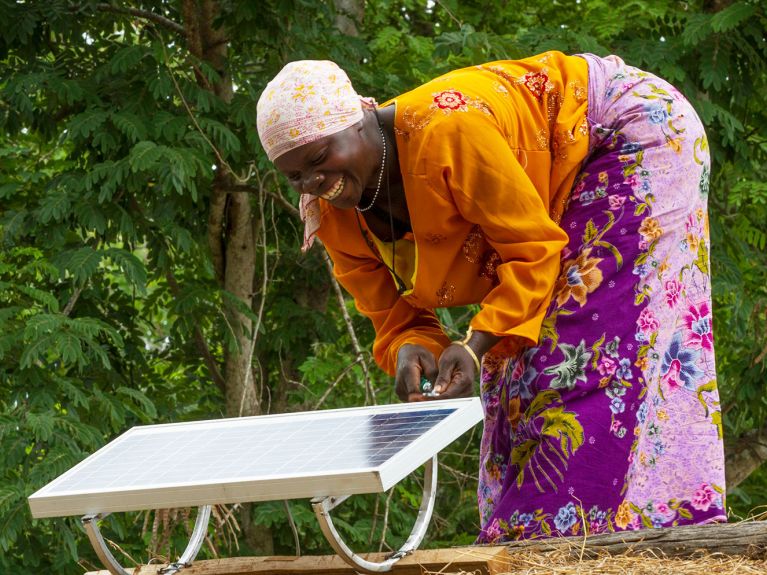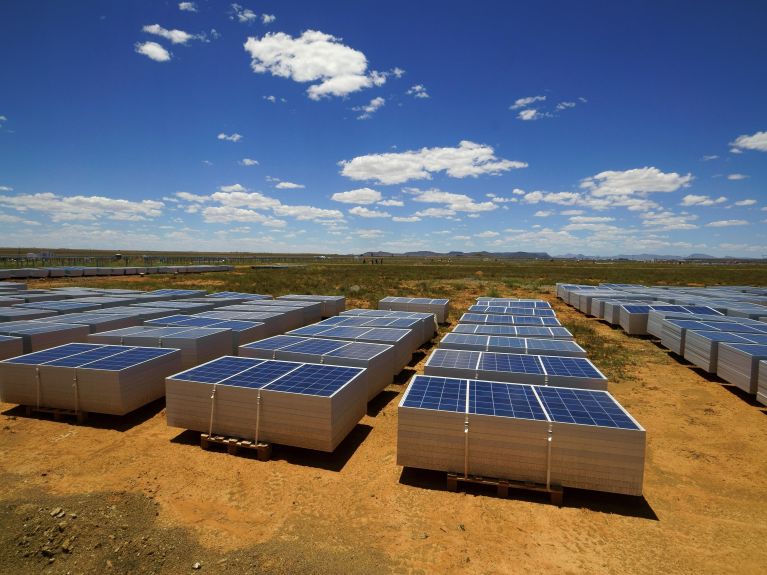New energy from Africa
How Germany and African countries are working together in energy partnerships to phase out fossil fuels.

Stefan Liebing had a competitive advantage. As chair of the German-African Business Association (Afrika-Verein, AV) he is very well acquainted with Africa and knows that there is a hydroelectric power plant in the south-west African state of Angola that is running at only half capacity. The turbines of the Laúca reservoir just over 200 kilometres east of the capital Luanda can actually generate two gigawatts of electricity: however, there is only enough demand for half of this amount. The rest is available at low cost, as Liebing found out: a unique opportunity to put his vision into practice.
Green hydrogen as the energy source of the future
As someone who knows Africa well, the head of the Hamburg consulting firm 'Consulta' also knew what the sun-drenched continent is well suited for – better than almost any other – namely for the production of 'green hydrogen', regarded by some as the 'energy source of the future,' by others as the overpriced 'champagne of the energy transition'. The latter, however, only applied until Vladimir Putin's invasion of Ukraine: since this 'historic turning point', the energy producers' calculating machines have also been working differently. Now, environment-friendly hydrogen is recognized as playing the main role in phasing out fossil fuels.
Hydrogen is produced by electrolysis, which splits water into oxygen and hydrogen. Electrolysis requires a considerable amount of energy, which can be supplied by natural gas or petroleum: but this is then 'brown' or 'grey' hydrogen, and producing it involves blowing large quantities of carbon dioxide into the atmosphere. Hydrogen is only 'green' if it is produced with renewable electricity – and this is where Africa comes in, with its blazing sun, gusty winds, 30,000-kilometre coastline and mighty rivers.
Dieses YouTube-Video kann in einem neuen Tab abgespielt werden
YouTube öffnenThird party content
We use YouTube to embed content that may collect data about your activity. Please review the details and accept the service to see this content.
Open consent formGreen hydrogen from Angola
All of this is can be found in Angola. For the time being, the surplus electricity of the Laúca power plant and the water of the Dande River will be enough for Stefan Liebing. Together with the Nuremberg-based engineering firm Gauff and the Angolan oil company Sonangol, Liebing – an energy expert with a PhD to prove it – aims to build the continent's first hydrogen factory. The plant, planned on the Atlantic coast a few kilometres north of Luanda, will produce enough hydrogen to generate 400 megawatts of electricity; it will cost half a billion euros. If all goes well, the project will be ready by the end of 2024 – and the 'energy partnership' that has been agreed between the German and Angolan governments is also expected to help with the project. The first tankers will then leave Barro do Dande to ship the hydrogen – combined with nitrogen to form ammonia – to Germany.
Dieses YouTube-Video kann in einem neuen Tab abgespielt werden
YouTube öffnenThird party content
We use YouTube to embed content that may collect data about your activity. Please review the details and accept the service to see this content.
Open consent form
Over the past ten years, the German government has already concluded energy partnerships with more than 20 countries around the world. They are intended to help both Germany and its partner states to wean themselves off fossil fuels by the middle of the 21st century at the latest. Above all, they aim to help the governments of the partner countries establish an environmentally friendly energy industry – co-determining its goals and guidelines, initiating projects, helping to train specialists and building the necessary infrastructure.
Hydrogen partnership between Germany and Namibia
Just like in the development of the port in Lüderitz – a small town in southern Namibia built during the German colonial era. Diamonds were once shipped from here; later, fish were brought ashore; finally the sleepy little town was in danger of being buried under desert sand. But now the largest hydrogen factory on the continent is to be built in Lüderitz. In as little as three years, a consortium with the participation of the Brandenburg energy company Enertrag plans to produce 300,000 tonnes of hydrogen a year here between the sea and the desert. This could almost completely supply Berlin with electricity, for example. The plant, which includes a wind park, a solar farm, a water desalination plant, and the electrolysis operation, will cost nearly 10 billion euros. But James Mnyupe, Namibia's commissioner for green hydrogen, wants more. His aim is to transform the desert state into a 'powerhouse for synthetic fuels'. And the hydrogen partnership with Germany signed a year ago will help in this context.

International energy partnership with South Africa
The continent's real energy giant, however, is South Africa – in both a negative and a positive sense. Even today, this economically strong country produces almost 90 percent of its electricity with coal: South Africa is one of the world's twelve largest emitters of CO2. At the same time, South Africa – like Namibia – has more than twice as many hours of sunshine than Germany, plus semi-deserts and a 2,800-kilometre wind-swept coastline. During the 2021 UN Climate Change Conference in Glasgow, the governments of the United States, the United Kingdom, the European Union, France and Germany pledged to help the country finance its energy transition under the title 'Just Energy Transition Partnership.' Germany will initially contribute US$800 million.
The energy partnership with Germany is also part of this major effort. Its field of activity is divided into six areas, including energy storage, flexibilization and green hydrogen. In this way, the Cape of Good Hope could be transformed into a beacon of hope for the energy transition.



